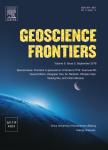Burial and exhumation history of the Xigaze forearc basin, Yarlung suture zone. Tibet
Burial and exhumation history of the Xigaze forearc basin, Yarlung suture zone. Tibet作者机构:Department of Earth Sciences Montana State University
出 版 物:《Geoscience Frontiers》 (地学前缘(英文版))
年 卷 期:2019年第10卷第3期
页 面:895-908页
核心收录:
学科分类:07[理学]
基 金:supported by the U.S. National Science Foundation Continental Dynamics Program (EAR-1008527 Lead PI, P. Kapp)
主 题:Xigaze Tibet Forearc basin Thermochronology Yarlung
摘 要:The Cretaceous-Eocene Xigaze forearc basin is a crucial data archive for understanding the tectonic history of the Asian continental margin prior to and following collision with India during the early Cenozoic Era. This study reports apatite and zircon(U-Th)/He thermochronologic data from fourteen samples from Albian-Ypresian Xigaze forearc strata to determine the degree and timing of heating(burial) and subsequent cooling(exhumation) of two localities along the Yarlung suture zone(YSZ) near the towns of Saga and Lazi. Thirty-seven individual zircon He ages range from 31.5 ± 0.8 Ma to6.06 ± 0.18 Ma,with the majority of grains yielding ages between 30 Ma and 10 Ma. Twenty apatite He ages range from 12.7 ± 0.5 Ma to 3.9 ± 0.3 Ma,with the majority of grains yielding ages between 9 Ma and 4 Ma. These ages suggest that the Xigaze forearc basin was heated to 140-200 ℃ prior to cooling in Oligocene-Miocene time. Thermal modeling supports this interpretation and shows that the samples were buried to maximum temperatures of ~140-200 0 C by 35-21 Ma, immediately followed by the onset of exhumation. The zircon He and apatite He dataset and thermal modeling results indicate rapid exhumation from ~21 Ma to 15 Ma, and at ~4 Ma. The 21-15 Ma thermochronometric signal appears to be regionally extensive, affecting all the lithotectonic units of the YSZ, and coincides with movement along the north-vergent Great Counter Thrust system. Thrusting, coupled with enhanced erosion possibly related to the paleo-Yarlung River, likely drove Early Miocene cooling of the Xigaze forearc *** contrast, the younger phase of rapid exhumation at ~4 Ma was likely driven by enhanced rock uplift in the footwall of north-striking rifts that cross-cut the YSZ.



